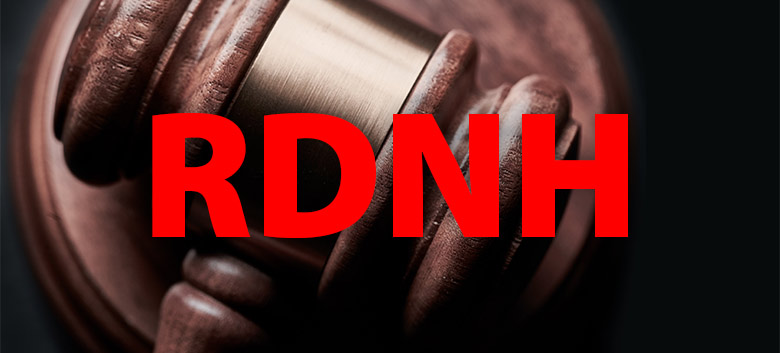Nutriforce France SAS has joined the club of UDRP filers that not only did not get the domain but were also told that they engaged in Reverse Domain Name Hijacking.
The decision involved the domain Nutriforce.com, an asset of SyncPoint, Inc operated by domain investor and entrepreneur, David Lahoti, who owned the domain since 2020. The Complainant’s company appears to have formed three years later.
The Complainant attempted to buy the domain via WhatsApp for the sum of $80 dollars. That ridiculous amount wasn’t motivating and when the Respondent did not complete such a transaction the Complainant filed a UDRP.
The sole WIPO panelist said:
The Complaint included no details or evidence regarding the date of commencement of the Complainant’s trading activity, which the Complainant should have known was an important point. And then, after the Respondent raised the timing issue, the Complainant replied with a vague and unsupported statement which was likely designed to give the misleading impression that the Complainant did possess prior rights.
In what is known as “Plan B”, the Complainant made an unsuccessful attempt to acquire the disputed domain name without giving any hint that the Complainant possessed a legal claim to the disputed domain name and, when that approach failed, the Complainant filed the Complaint without any plausible legal basis.
Final decision: Deny the transfer of the domain Nutriforce.com with a finding of Reverse Domain Name Hijacking. The Respondent shares this fact on the domain name, Nutriforce.com.

Copyright © 2025 DomainGang.com · All Rights Reserved.ARBITRATION AND MEDIATION CENTER
ADMINISTRATIVE PANEL DECISION
Nutriforce France SAS v. Tech Ops, SyncPoint, Inc.
Case No. D2025-03671. The Parties
The Complainant is Nutriforce France SAS, France, internally represented.
The Respondent is Tech Ops, SyncPoint, Inc., United States of America (“U.S.”), internally represented.
2. The Domain Name and Registrar
The disputed domain name nutriforce.com is registered with Dynadot Inc (the “Registrar”).
3. Procedural History
The Complaint was filed with the WIPO Arbitration and Mediation Center (the “Center”) on January 30, 2025. On January 30, 2025, the Center transmitted by email to the Registrar a request for registrar verification in connection with the disputed domain name. On February 2, 2025, the Registrar transmitted by email to the Center its verification response disclosing registrant and contact information for the disputed domain name which differed from the named Respondent (Dave Lahoti) and contact information in the Complaint. The Center sent an email communication to the Complainant on February 3, 2025, providing the registrant and contact information disclosed by the Registrar, and inviting the Complainant to submit an amendment to the Complaint. The Complainant filed an amended Complaint on February 3, 2025.
The Center verified that the Complaint together with the amended Complaint satisfied the formal requirements of the Uniform Domain Name Dispute Resolution Policy (the “Policy” or “UDRP”), the Rules for Uniform Domain Name Dispute Resolution Policy (the “Rules”), and the WIPO Supplemental Rules for Uniform Domain Name Dispute Resolution Policy (the “Supplemental Rules”).
In accordance with the Rules, paragraphs 2 and 4, the Center formally notified the Respondent of the Complaint, and the proceedings commenced on February 4, 2025. In accordance with the Rules, paragraph 5, the due date for Response was February 24, 2025. The Response was filed with the Center on February 24, 2025. The Complainant submitted a supplemental filing on February 24, 2025.
The Center appointed Adam Taylor as the sole panelist in this matter on February 25, 2025. The Panel finds that it was properly constituted. The Panel has submitted the Statement of Acceptance and Declaration of Impartiality and Independence, as required by the Center to ensure compliance with the Rules, paragraph 7.
The Respondent submitted a supplemental filing on February 28, 2025.
4. Factual Background
The Complainant sells food supplements under the mark NUTRIFORCE via a website at “www.nutriforce.fr”. That domain name was registered on March 17, 2023.
The Complainant owns a number of registered trade marks for NUTRIFORCE including French trade mark No. 4950638, filed on April 3, 2023, registered on July 21, 2023, in class 5.
The disputed domain name was created on April 1, 2002. The Respondent states that it acquired the disputed domain name in an expired domain name auction on an unspecified date in September 2020. The Panel also takes note of the Complainant’s statement that the disputed domain name “has been parked since its registration in 2020”.
As of September 2022, the disputed domain name resolved to a webpage headed “NutriForce.com. Site Name Available”, with a “Make An Offer” button. The site also stated that “Over 9 Sites start with “NutriForce” and listed at least eight domain names starting with that term.
On an unspecified later date, the webpage had changed to include a “Contact via WhatsApp” button plus a list of other domain names (unrelated and dissimilar to the NUTRIFORCE trade mark and which, on the face of it, reflect descriptive words/phrases) for sale at prices ranging from USD 24,1000 to USD 531,800.
On or around December 5, 2024, the Complainant contacted the Respondent via WhatsApp offering USD 80 for the disputed domain name. The Respondent replied saying that “[w]e can just donate the NutriForce.com site name to you” and inviting the Complainant to submit a draft transfer agreement by Monday. The Complainant replied by sending the transfer agreement. There then followed numerous chasers by the Complainant in the course of which the Complainant upped its offer to USD 1,000. The Complainant’s messages were punctuated by occasional brief and unspecific replies from the Respondent. At some point in January, the Respondent asked why the Complainant was being so impatient for a domain name that was worth only USD 80 to the Complainant, explained that it had been busy for various reasons and concluded: “Let’s just cancel this for now.” The Respondent did not respond to the Complainant’s subsequent messages, which explained that the Complainant needed the disputed domain name for a project and invited the Respondent to put forward a price for the disputed domain name.
As of February 24, 2025, the disputed domain name resolved to a webpage that was headed “Nutriforce France SAS: Attempted Reverse Domain Name Hijacking” and summarised the Respondent’s contentions regarding RDNH in this proceeding.
5. Parties’ Contentions
A. Complainant
The Complainant contends that it has satisfied each of the elements required under the Policy for a transfer of the disputed domain name.
Notably, the Complainant contends that:
– the Respondent has no registered trade marks, company names, or business activities associated with the term “Nutriforce”;
– the disputed domain name has been parked since its acquisition by the Respondent in 2020 with no active website or legitimate use;
– the absence of website content linked to “Nutriforce” is indicative of a lack of legitimate interest in the disputed domain name;
– the Respondent has previously been found guilty of abusive domain name registration in Cloudmark, Inc. v. Dave Lahoti and Interspectrum, WIPO Case No. D2003-0797;
– the Respondent has passively held the disputed domain name in bad faith;
– the Complainant attempted to contact the Respondent multiple times to enquire about the disputed domain name but the Respondent engaged in deceptive and time-wasting conversations and ultimately refused to sell to the Complainant without justification, leading to the inference that the Respondent intends to artificially inflate the value of the disputed domain name or obstruct the Complainant’s business expansion; and
– the Respondent holds multiple premium domain names listed for sale at exorbitant prices, indicating a pattern of bad faith registration, namely acquiring domain names not for genuine business purposes but solely to hold them hostage for speculative gains.
B. Respondent
The Respondent contends that the Complainant has not satisfied all three of the elements required under the Policy for a transfer of the disputed domain name.
Notably, the Respondent contends that:
– the Complainant’s company did not exist at the time of the Respondent’s acquisition of the disputed domain name;
– the Complainant’s domain name nutriforce.fr, and French trade mark, postdate the disputed domain name by some three years;
– the Complainant’s own evidence from 2020 shows multiple unrelated entities using “Nutriforce” in commerce;
– passive holding is permissible and the Respondent has neither used the disputed domain name in bad faith nor attempted to mislead customers;
– the Respondent never engaged in bad faith efforts to sell the disputed domain name;
– the Complainant initiated negotiations with the Respondent to purchase the domain but exhibited
aggressive and unreasonable behavior;
– the Complainant is guilty of RDNH;– the Complainant resorted to this UDRP proceeding as a “Plan B” strategy after failing to purchase the disputed domain name; and
– the Complainant knowingly filed a baseless Complaint despite being aware of third party use of “Nutriforce”.
6. Discussion and Findings
6.1 Preliminary Issue – Supplemental Filing
Each party has made an unsolicited supplemental filing.
Paragraph 10(d) of the Rules gives the panel authority to determine the admissibility, relevance, materiality and weight of the evidence. Paragraph 10(a) requires the Panel to conduct the proceedings with due expedition.
UDRP panels have repeatedly affirmed that the party submitting an unsolicited supplemental filing should clearly show its relevance to the case and why it was unable to provide the information contained therein in its complaint or response, e.g., owing to some “exceptional” circumstance. WIPO Overview of WIPO Panel Views on Selected UDRP Questions, Third Edition (“WIPO Overview 3.0”), section 4.6.
In this case, the Panel has decided to reject the bulk of both filings on the grounds that the material therein is repetitive, or standard rebuttal, or could have been included in the party’s primary submission, or the Panel considers it immaterial to its decision. However, the Panel has decided to admit a number of factual matters/allegations in the Complainant’s submission as well the Complainant’s response to the Respondent’s assertion of RDNH. These are referred to below where relevant.
The Panel would add, however, that even if the disallowed material in the supplemental filings had been admitted, it would have made no difference to the outcome of this case.
6.2 Substantive Issues
A. Identical or Confusingly Similar
It is well accepted that the first element functions primarily as a standing requirement. The standing (or threshold) test for confusing similarity involves a reasoned but relatively straightforward comparison between the Complainant’s trade mark and the disputed domain name. WIPO Overview 3.0, section 1.7.
The Complainant has shown rights in respect of a trade mark or service mark for the purposes of the Policy. WIPO Overview 3.0, section 1.2.1.
The entirety of the mark is reproduced within the disputed domain name. Accordingly, the disputed domain name is identical to the mark for the purposes of the Policy. WIPO Overview 3.0, section 1.7.
The Panel finds the first element of the Policy has been established.
B. Rights or Legitimate Interests
It is unnecessary to consider this element in view of the Panel’s findings under the third element below.
C. Registered and Used in Bad Faith
Except for limited circumstances involving registration of a domain name to capitalise on nascent trade mark rights, panels will not normally find bad faith on the part of the respondent where a respondent registers a domain name before the complainant’s trade mark rights accrue. WIPO Overview 3.0, section 3.8.1.
The Complainant’s earliest registered trade mark was filed on April 3, 2023.
The Complainant gives little detail about its business, including the start date, but it does not contest the Respondent’s evidence that it registered nutriforce.fr, the domain name used for its main website, on March 17, 2023.
In response to the Respondent’s contention that the Complainant’s business did not exist when the Respondent acquired the disputed domain name in September 2020, the Complainant states in its supplemental filing that “‘Nutriforce’ […] was already distinctive when acquired.” Insofar as the Complainant is claiming that it possessed trade mark rights by the time that the Respondent acquired the disputed domain name in September 2020, this statement carries no weight because it is entirely unsupported by dated evidence.
Accordingly, and in the absence of any evidence from the Complainant to the contrary, the Panel proceeds on the basis that the Complainant’s trade mark rights arose in 2023 at the earliest, as per the evidence provided in the Complaint, thereby post-dating the disputed domain name by some three years.
In those circumstances, the disputed domain name could not have been registered in bad faith. This is fatal to the Complainant’s case – irrespective of the nature of any later use of the disputed domain name and of any other adverse UDRP decisions against the Respondent – because the Complainant is required to prove both registration and use in bad faith.
The Panel finds the third element of the Policy has not been established.
D. Reverse Domain Name Hijacking
Paragraph 15(e) of the Rules provides that, if “after considering the submissions the panel finds that the complaint was brought in bad faith, for example in an attempt at Reverse Domain Name Hijacking or was brought primarily to harass the domain-name holder, the panel shall declare in its decision that the complaint was brought in bad faith and constitutes an abuse of the administrative proceeding”. RDNH is defined under the Rules as “using the Policy in bad faith to attempt to deprive a registered domain-name holder of a domain name”. The mere lack of success of the complaint is not, on its own, sufficient to constitute reverse domain name hijacking. WIPO Overview 3.0, section 4.16.
The reasons articulated by panels for finding RDNH, as set out in section 4.16 of WIPO Overview 3.0, include, inter alia, the following:
– facts which demonstrate that the complainant knew it could not succeed as to any of the required three elements – such as the clear knowledge of a lack of respondent bad faith including registration of the disputed domain name well before the complainant acquired trade mark rights;
– facts which demonstrate that the complainant clearly ought to have known it could not succeed under any fair interpretation of facts reasonably available prior to the filing of the complaint;
– unreasonably ignoring established Policy precedent notably as captured in the WIPO Overview – except in limited circumstances which prima facie justify advancing an alternative legal argument;
– the provision of intentionally incomplete material evidence – often clarified by the respondent; and
– filing the complaint after an unsuccessful attempt to acquire the disputed domain name from the respondent without a plausible legal basis.
For the following reasons, the Panel considers that the above factors apply in this case.
The Complainant was well aware that its rights post-dated the disputed domain name as the Complaint acknowledges that the Respondent acquired the disputed domain name in 2020.
The Complaint referred to previous UDRP decisions, indicating that the Complainant was likely familiar with established Policy precedent including the need to demonstrate the existence of trade mark rights as of the date of the registration of the disputed domain name.
The Complaint included no details or evidence regarding the date of commencement of the Complainant’s trading activity, which the Complainant should have known was an important point. And then, after the Respondent raised the timing issue, the Complainant replied with a vague and unsupported statement which was likely designed to give the misleading impression that the Complainant did possess prior rights.
In what is known as “Plan B”, the Complainant made an unsuccessful attempt to acquire the disputed domain name without giving any hint that the Complainant possessed a legal claim to the disputed domain name and, when that approach failed, the Complainant filed the Complaint without any plausible legal basis. For example, aside from the fatal flaw that the Complainant’s rights post-dated the Respondent’s acquisition of the disputed domain name, the Complainant has raised baseless arguments that unreasonably ignore established Policy precedent, e.g., attacking the right of the Respondent to deal in domain names for profit whereas it is well established that this practice of itself is entirely legitimate in the absence of any intent to target a complainant’s trade mark. WIPO Overview 3.0, section 3.1.1.
Based on the available record, the Panel finds that the Complaint was brought in bad faith and constitutes an abuse of the administrative proceeding.7. Decision
For the foregoing reasons, the Complaint is denied. Moreover, the Panel finds that the Complaint has been brought in bad faith and constitutes an attempt at Reverse Domain Name Hijacking.
/Adam Taylor/
Adam Taylor
Sole Panelist
Date: March 11, 2025










